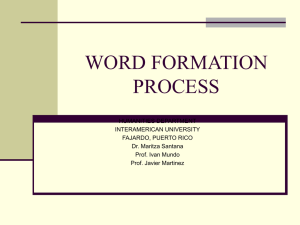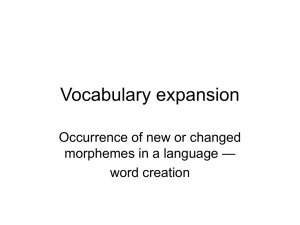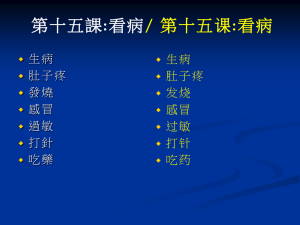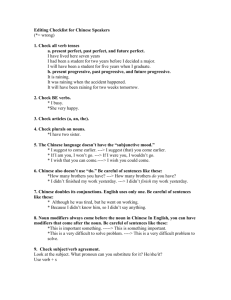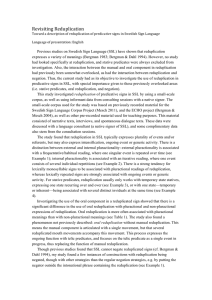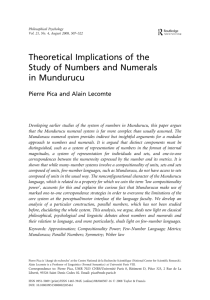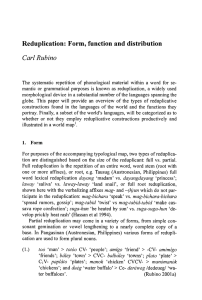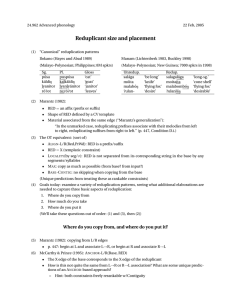Ideophonic Reduplication of Content Words in Mandarin Chinese: A
advertisement
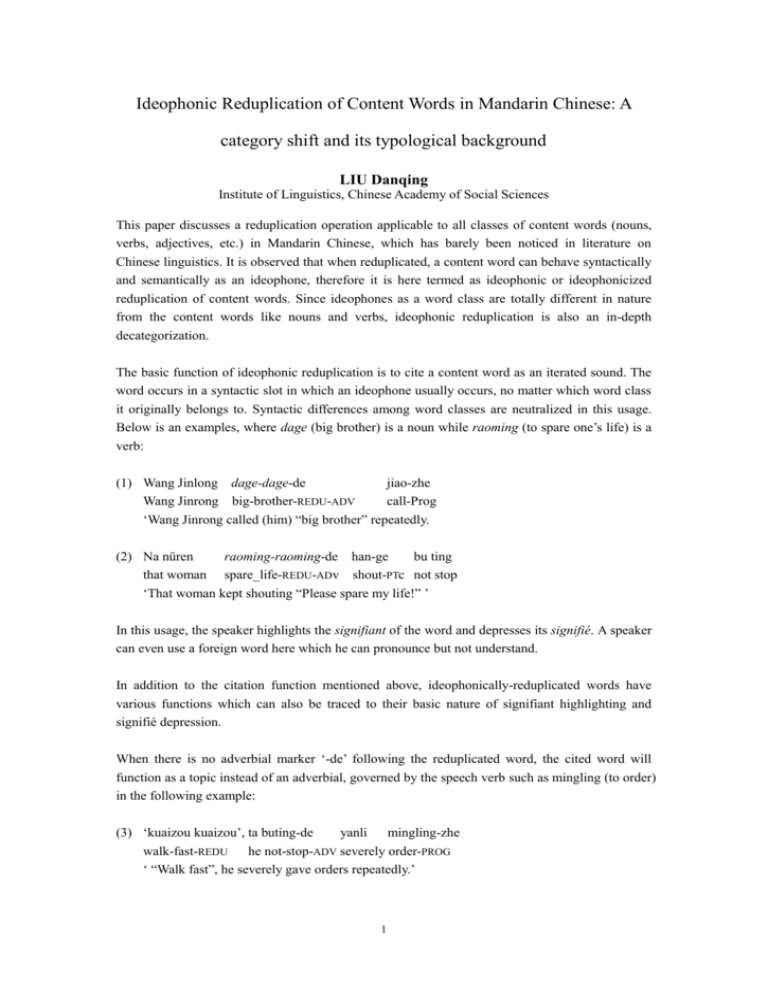
Ideophonic Reduplication of Content Words in Mandarin Chinese: A category shift and its typological background LIU Danqing Institute of Linguistics, Chinese Academy of Social Sciences This paper discusses a reduplication operation applicable to all classes of content words (nouns, verbs, adjectives, etc.) in Mandarin Chinese, which has barely been noticed in literature on Chinese linguistics. It is observed that when reduplicated, a content word can behave syntactically and semantically as an ideophone, therefore it is here termed as ideophonic or ideophonicized reduplication of content words. Since ideophones as a word class are totally different in nature from the content words like nouns and verbs, ideophonic reduplication is also an in-depth decategorization. The basic function of ideophonic reduplication is to cite a content word as an iterated sound. The word occurs in a syntactic slot in which an ideophone usually occurs, no matter which word class it originally belongs to. Syntactic differences among word classes are neutralized in this usage. Below is an examples, where dage (big brother) is a noun while raoming (to spare one’s life) is a verb: (1) Wang Jinlong dage-dage-de jiao-zhe Wang Jinrong big-brother-REDU-ADV call-Prog ‘Wang Jinrong called (him) “big brother” repeatedly. (2) Na nüren raoming-raoming-de han-ge bu ting that woman spare_life-REDU-ADv shout-PTc not stop ‘That woman kept shouting “Please spare my life!” ’ In this usage, the speaker highlights the signifiant of the word and depresses its signifié. A speaker can even use a foreign word here which he can pronounce but not understand. In addition to the citation function mentioned above, ideophonically-reduplicated words have various functions which can also be traced to their basic nature of signifiant highlighting and signifié depression. When there is no adverbial marker ‘-de’ following the reduplicated word, the cited word will function as a topic instead of an adverbial, governed by the speech verb such as mingling (to order) in the following example: (3) ‘kuaizou kuaizou’, ta buting-de yanli mingling-zhe walk-fast-REDU he not-stop-ADV severely order-PROG ‘ “Walk fast”, he severely gave orders repeatedly.’ 1 If the predicative verb is not a speech verb and cannot govern the topic, the topic in reduplicated form will be a non-gap topic, and the reduplication thus serves as a sort of topic marker. Semantically, the topic still denotes a cited word from the current context. The reduplicated topic tends to refer to something unwelcome, probably because repeating a word more than one time in speech is a boring or annoying business. For instance: (4) mei-qian mei-qian, ni hai you wan mei wan? no-money-REDU you still have end not end ’(I just heard you said)no money so many times, will you put an end to this!’ When the reduplicated word and the following part are semantically contrary, and the reduplicated word is cited from the current context, or from a general social context, indicating a frequently-mentioned event or state, the whole sentence can be reanalyzed into a concessive structure, the reduplicated word being the concessive. For instance: (5) Chifan-chifan, mi hai mei tao ne. eat_meal-REDU raw_rice yet not wash PTC ‘Although you said “have meal”, the raw rice hasn’t be washed yet’ Finally, based on its citation function, the reduplicated word can occur as an entry term with its following part as a paraphrasing gloss for it. Since the reduplicated word assumes its function mainly with its signifiant rather than its signifié, the gloss is usually made on the basis of its sound or word form, and is often a rhetoric one rather than a seriously philological one. For example: (6) Ganbu-ganbu, shi gan-chulai de. cadre-REDU, be do-out PTC. ‘A cadre, means one should do things to be a better cadre’ Since the word ganbu (cadre) contains a syllable ‘gan’, which happens to share the pronunciation and Chinese character with the verb gan (to do), so the speaker uses this verb to rhetorically gloss the noun. In sum, ideophonic reduplication is a category shift device in Mandarin Chinese, which can turn a content word of any class into an ideophone, highlighting the signifiant of the word while depressing its signifié. Based on this nature, various functions of the ideophonically-reduplicated word are developed. It can serve as a cited topic, as a non-gap topic, a concessive clause, or as an entry term to be glossed. Such kind of category shift device has rarely been reported and discussed in the literature of linguistics so far and is thus worthy of note. Finally, typlogical characteristics of Chinese underlying ideophonic reduplication is discussed. Wide use of reduplication in Chinese, topic prominence, and fuzzy boundaries among the levels of words, phrases and sentences are found to be factor fostering the construction. 2
